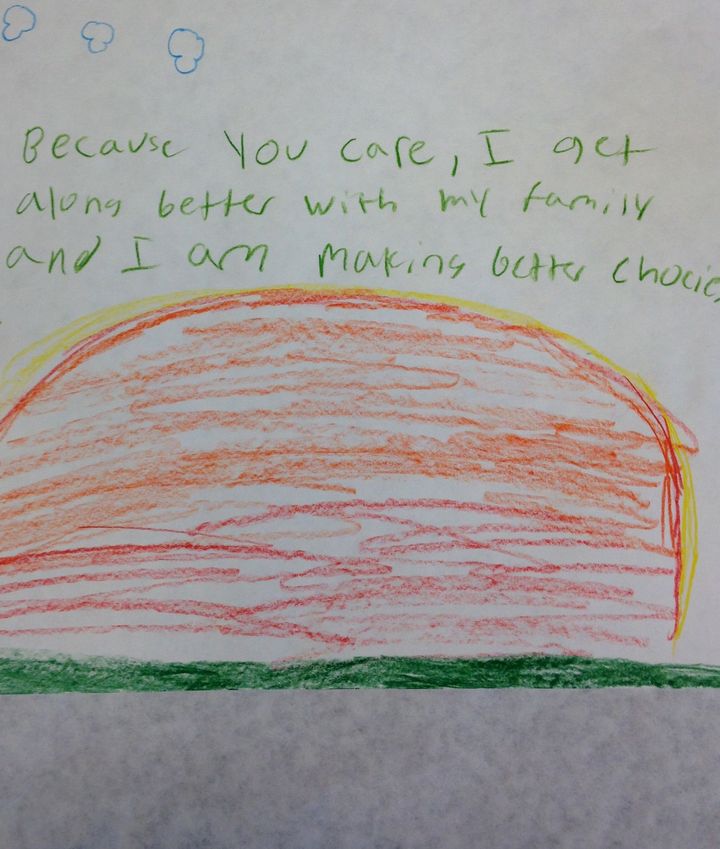People don’t realize that molecules themselves are somewhat hypothetical, and that their interactions are more so, and that the biological reactions are even more so. ~Kary Mullis
You never know who you will make a lifelong impression on.
Working in mental health in the form of Art Therapy, from youth to the elderly, these individuals come from all walks of life. Their works of art come with profound attachment of a deep seeded memory of words that were said to them or actions taken upon them, and has in a sense, transformed them for better or worse.
The brain is complex and fascinating in registering and storing thoughts and emotions; the greater sense of positive and negative experiences received, the stronger the encoding and retrieval process gets. Through art-making and the meaning behind it- it is striking how deeply words and actions can affect our brains, right down to the core of our existence. Some people are able to thrive in a world full of complexities while others struggle through as they carry on; some build their walls up with anger, fear and resentment, and some remain in despair, unraveling and losing hope. From family members, friends, colleagues to strangers we may encounter, any verbal and physical action we choose to make, may end up creating a lasting impression on how our choices affected another life.
An elderly man in his 70’s has limited use of his arm that will droop down while sitting in a group art therapy session. He hasn’t done a lot of art in his life, thinking he couldn’t do it, and now in his 70’s he finds joy and ownership in his creations. It is difficult for him to manipulate mediums like oil pastels, colored pencils or markers as his hands will curl in, but paint is provided with paintbrushes that offer a grip handle that is easier to use. On one particular session everyone was using colored pencils and markers and he grabbed a colored pencil and began to carefully draw tiny leaves and fill each one in with color. He complained how much his hand hurt and he was offered paints that he declined. He wanted to do this on his own terms. Upon the hour he laughed brilliantly and said, “My hand hurts like hell, but I did it!”
In art therapy the process of how art is created is observed; it is not simply about what art mediums are used or what the quality of the art outcome is; art therapy is a combination of all of these things that support participants in their personal journey, under the guidance of a registered Art Therapist. As this man massaged his hand, smiling and laughing at his creative accomplishment, another participant asked him what happened to his hand, wondering if he had a stroke. He said he was badly beaten as a child by his schoolteacher and that was accepted back then. He shared the physical beatings he endured throughout his child and adolescent years and as a result it gave him nerve damage. The hateful words that people spewed at him equaled the physical pain. His anger, resentment, shame and depression reflected in his failed relationships later on in life. Over the years he struggled to get through the pain, but he was able to find supportive mentors that cared. He credits those who encouraged him and he credits his attitude and willingness to find self-empowerment and a demand for positive change.
The metaphor of his creative process in his art may be seen as his determination and satisfaction in overcoming the hurts, proving that he has prevailed. Everyone at the senior center, where he attends weekly, loves, embraces, and encourages him. The negative experiences now caressed into something positive has made a world of a difference in this man’s life.
A younger man in his 40’s has some developmental challenges and he never considered himself to be artistic. His drawings are rudimentary and beautiful. He will say his art is not good and sheepishly put his head down, but he likes to be creative and the others in his community encourage him and praise his work. He beams. He often attempts to draw figures of people or will cut out pictures from a magazine as a representation of someone he knows, or once knew. He reminiscences on encounters with society and has talked about the traumas, but has learned to direct his thoughts to the positives. In his art there are several representations of people that he interacted with from his days in another city, in another state, in another time. “The mean ones who made fun of me and pushed me around are kept away,” he says. He has spoken about people that he did not have any close relationship with, but who have expressed genuine kindness in his encounters. It was those who showed niceness towards him that gave him some faith in humanity. Somewhere in the world there is a waitress, a bartender, flight attendant, physician, barista, sister, and librarian who have impacted a man’s life in a profound way. They may never know the positive impact they had on someone else, but I hope they do know on some level and remain unshaken in a chaotic society.
There are many who feel alone, angry, depressed and stigmatized, some who have contemplated suicide or wanted to hurt those who hurt them. Yet the majorities have found some positive outlets to redirect their attention when the residuals of trauma creeps up in the mind. Art can be a sacred release of the psyche. We are assaulted with negativity on a daily basis from a variety of outlets, and ultimately we have a choice as to how to react to those toxins. As a humanity we all play an active role in choosing how to behave, and despite who we are, our words and actions create lasting impacts, and may even go as far as saving a life. As one woman who is overcoming depression looks at her drawing of flowers and remarks, “I’ve had a lot of bad in my life, a lot of bad said to me and done to me. It seems easier to remember the bad, probably because there’s been so much of it, but there is good too and I don’t think I’d be here today if it weren’t for the good.”
Art is not meant to change the world, but when you see people interacting, when you see an impact on their lives, then I guess in a smaller way, this is changing the world. ~ JR

